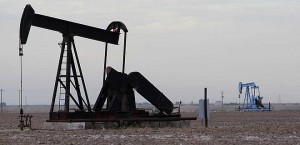 West Texas Intermediate crude held above the $102 mark after surging to the highest in four months on speculations supplies at Cushing, Oklahoma, fell for a third straight week and as frigid weather in the US probably drained the nations distillate fuel inventories for a sixth week. Ongoing turmoil in Libya, renewed tension in South Sudan and conflicts in Venezuela further supported the oil complex.
West Texas Intermediate crude held above the $102 mark after surging to the highest in four months on speculations supplies at Cushing, Oklahoma, fell for a third straight week and as frigid weather in the US probably drained the nations distillate fuel inventories for a sixth week. Ongoing turmoil in Libya, renewed tension in South Sudan and conflicts in Venezuela further supported the oil complex.
On the New York Mercantile Exchange, WTI crude for settlement in March traded at $102.78 per barrel at 8:02 GMT, up 0.34% on the day. Prices varied between days high of $103.14, close to yesterdays four-month high of $103.25, and days low of $102.65 per barrel. The US benchmark settled 2.1% higher on Tuesday at $102.43 per barrel, the highest close since October 10th. Prices are up 5% this month.
Meanwhile on the ICE, Brent futures for delivery in April slid by 0.18% to trade at $110.26 per barrel and held in a daily range between $110.55 and $110.10 per barrel. The European benchmark added 1.2% on Tuesday, having risen to a 1-1/2-month high of $110.70 a barrel. Brents premium to its US counterpart narrowed to $8.03 a barrel on Tuesday from $8.95 on Friday, based on closing prices.
WTI drew support amid expectations that both a private and a government report will show a further decline in distillate fuel inventories and supplies at Cushing, Oklahoma, the biggest US storage hub and delivery point for NYMEX-traded contracts.
According to a Reuters poll of analysts, US distillate fuel supplies probably slid by 1.8 million barrels in the seven days through February 14th, a sixth consecutive weekly decline, while gasoline inventories are expected to have declined by 900 000 barrels.
Meanwhile, stockpiles at Cushing likely dropped by between 1 million and 1.5 million barrels last week, according to Jim Ritterbusch, president of Ritterbusch & Associates, a Galena, Illinois-based consulting company. Carl Larry, president of Oil Outlooks & Opinions LLC in Houston, said for Bloomberg that inventories probably declined by 1.5 million barrels, while Phil Flynn, senior market analyst at Price Futures Group in Chicago, predicted a 1 million-barrel decrease.
Inventories at the hub have contracted by 4.23 million barrels in the two weeks ended February 8th as the southern leg of TransCanadas Keystone XL pipeline began moving oil from Cushing to the Gulf Coast, easing a bottleneck. Currently carrying around 290 000 barrels per day, the pipeline is expected to reach its full capacity of 700 000 barrels per day through the year.
Tony Nunan, a risk manager at Mitsubishi Corp, commented, cited by CNBC: “WTI just exploded. Its a combination of the unexpected severe winter and that drawdown at Cushing that caused us to go this high.”
Oil prices continued to draw support after a second storm in three days hit the Northeast and mid-Atlantic and will probably bring 5 inches of snow over Boston and New England, according to the National Weather Service. New York received 1.5 inches after it got another 3 inches on Saturday to a total of 55.6 inches accumulated during the winter. This is three times the average through mid-February, according to Tom Kines, a meteorologist for AccuWeather.com.
Venezuela, Africa
Further boosting prices, especially the Brent benchmark, Venezuelan security forces invaded the headquarters of an opposition party which was accused of fueling a week of violent protests as the OPEC member ousted three US diplomats due to an alleged conspiracy with demonstrators.
Meanwhile in South Sudan, rebels said that they have gained control over the capital of the oil-producing Upper Nile state on Tuesday, putting at doubt planned peace talks and breaching the truce.
Libyas nationwide output slid to around 375 000 barrels per day after protesters partially cut flows from the western El Sharara oilfield, the state-run National Oil Corporation said. That’s down around 80 000 bpd from a week earlier and below the previous stable rate of 600 000 bpd.
Market players also kept a close watch on talks between Iran and six world powers, which began yesterday, aimed at reaching a final long-term agreement between the two counterparts on curbing the Islamic republics nuclear program in exchange for lifting touch sanctions that crippled its economy.





